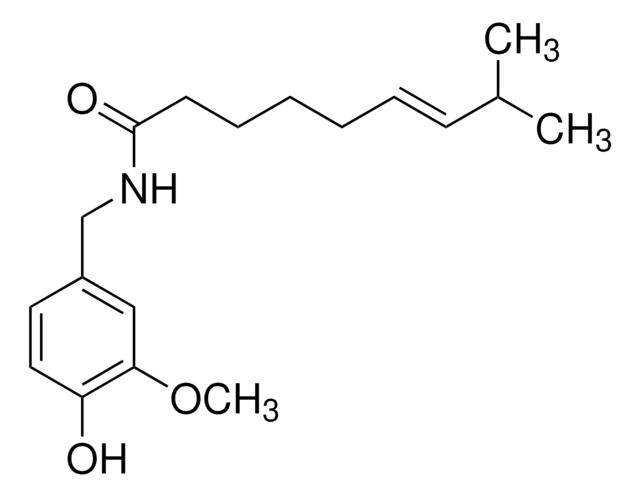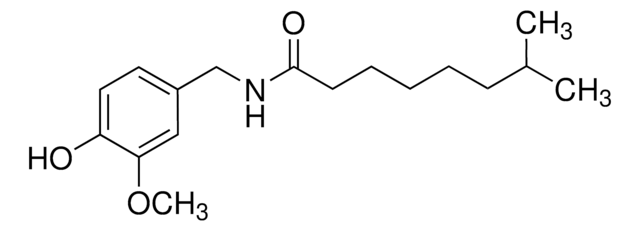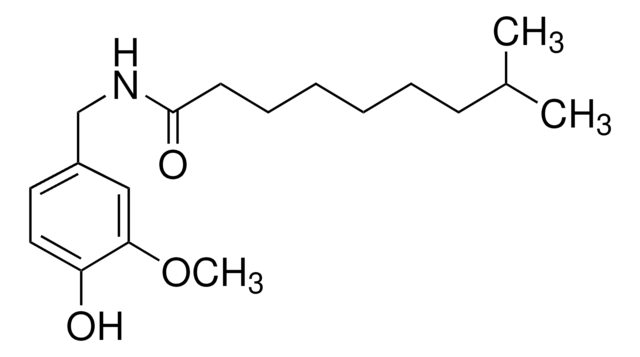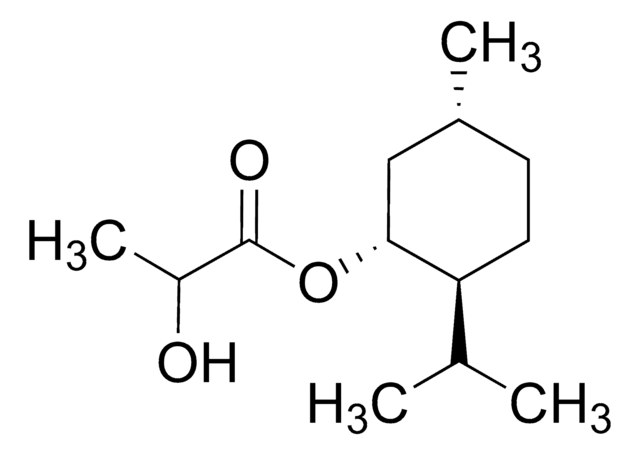全部照片(1)
About This Item
線性公式:
(CH3)2CHCH=CH(CH2)4CONHCH2C6H3-4-(OH)-3-(OCH3)
CAS號碼:
分子量::
305.41
Beilstein:
2816484
MDL號碼:
分類程式碼代碼:
41116107
PubChem物質ID:
NACRES:
NA.24
推薦產品
等級
pharmaceutical primary standard
API 家族
capsaicin
製造商/商標名
USP
mp
62-65 °C (lit.)
應用
pharmaceutical (small molecule)
形式
neat
儲存溫度
2-8°C
SMILES 字串
COc1cc(CNC(=O)CCCC\C=C\C(C)C)ccc1O
InChI
1S/C18H27NO3/c1-14(2)8-6-4-5-7-9-18(21)19-13-15-10-11-16(20)17(12-15)22-3/h6,8,10-12,14,20H,4-5,7,9,13H2,1-3H3,(H,19,21)/b8-6+
InChI 密鑰
YKPUWZUDDOIDPM-SOFGYWHQSA-N
基因資訊
human ... TRPV1(7442)
尋找類似的產品? 前往 產品比較指南
一般說明
This product is provided as delivered and specified by the issuing Pharmacopoeia. All information provided in support of this product, including SDS and any product information leaflets have been developed and issued under the Authority of the issuing Pharmacopoeia. For further information and support please go to the website of the issuing Pharmacopoeia.
應用
Capsaicin USP reference standard for use in specified quality tests and assays.
Also used to prepare standard solutions for the assay, identification, composition and strength analysis according to the given below monographs of United States Pharmacopeia (USP):
Also used to prepare standard solutions for the assay, identification, composition and strength analysis according to the given below monographs of United States Pharmacopeia (USP):
- Capsaicin
- Capsicum Oleoresin
- Capsicum
- Ginger Tincture
生化/生理作用
原型香草受体激动剂。 神经毒素;激活产生无髓C纤维的感觉神经元,其中许多含有P物质。 局部使用可使感觉神经末梢脱敏,从而产生反常的抗伤害感受作用;全身给药可对辣椒素敏感的细胞产生神经毒性,尤其是在新生动物中。辣椒的活性成分。
原型香草受体激动剂;神经毒素。辣椒的活性成分。
分析報告
These products are for test and assay use only. They are not meant for administration to humans or animals and cannot be used to diagnose, treat, or cure diseases of any kind.
其他說明
Sales restrictions may apply.
訊號詞
Danger
危險分類
Acute Tox. 2 Oral - Eye Dam. 1 - Resp. Sens. 1 - Skin Irrit. 2 - Skin Sens. 1 - STOT SE 3
標靶器官
Respiratory system
儲存類別代碼
6.1A - Combustible acute toxic Cat. 1 and 2 / very toxic hazardous materials
水污染物質分類(WGK)
WGK 3
閃點(°F)
235.4 °F - closed cup
閃點(°C)
113 °C - closed cup
客戶也查看了
Capsicum Oleoresin
United States Pharmacopeia, 38(4), 730-730 (2019)
Capsaicin
United States Pharmacopeia, 727-727 (2013)
Maija Haanpää et al.
European neurology, 68(5), 264-275 (2012-10-06)
Capsaicin has long been used as a traditional medicine to treat pain and, recently, its mechanism of analgesic action has been discovered. This review article documents the clinical development of capsaicin to demonstrate that pharmacognosy still has a profound influence
Jessica O'Neill et al.
Pharmacological reviews, 64(4), 939-971 (2012-10-02)
A large number of pharmacological studies have used capsaicin as a tool to activate many physiological systems, with an emphasis on pain research but also including functions such as the cardiovascular system, the respiratory system, and the urinary tract. Understanding
Astrid J Terkelsen et al.
Anesthesiology, 120(5), 1225-1236 (2014-03-14)
Complex regional pain syndrome is multifactorial. Exaggerated inflammatory responses to limb injury may be involved. The authors hypothesized that capsaicin-induced pain and neurogenic inflammation (skin perfusion and flare area) are increased in patients with complex regional pain syndrome compared with
我們的科學家團隊在所有研究領域都有豐富的經驗,包括生命科學、材料科學、化學合成、色譜、分析等.
聯絡技術服務









